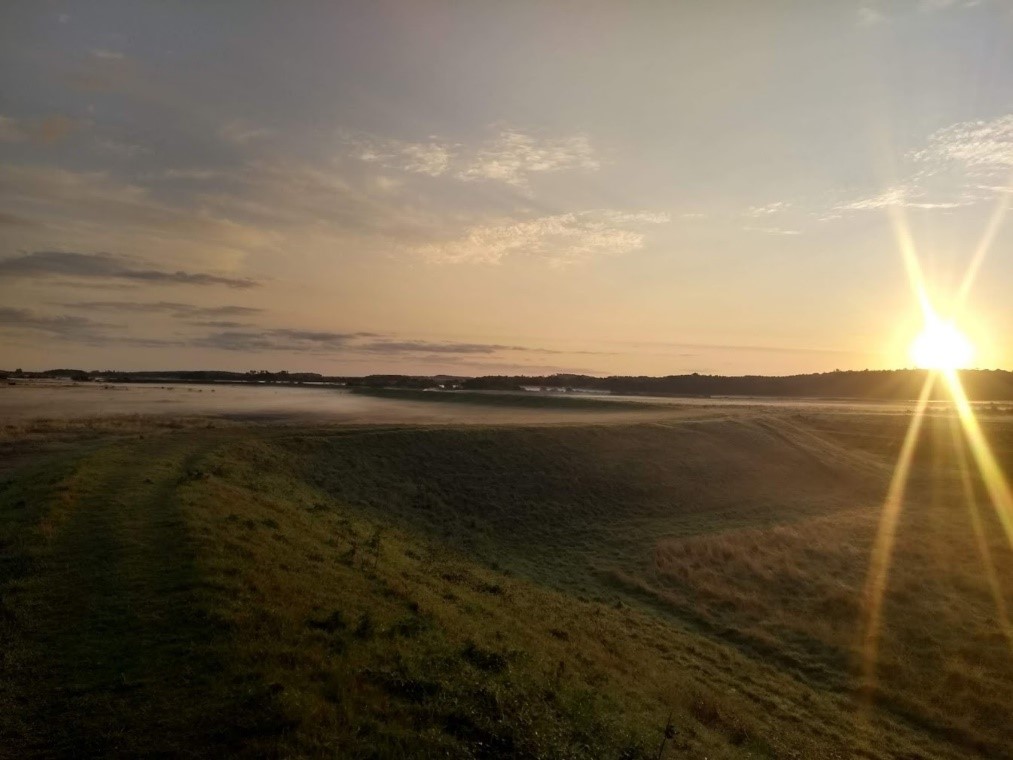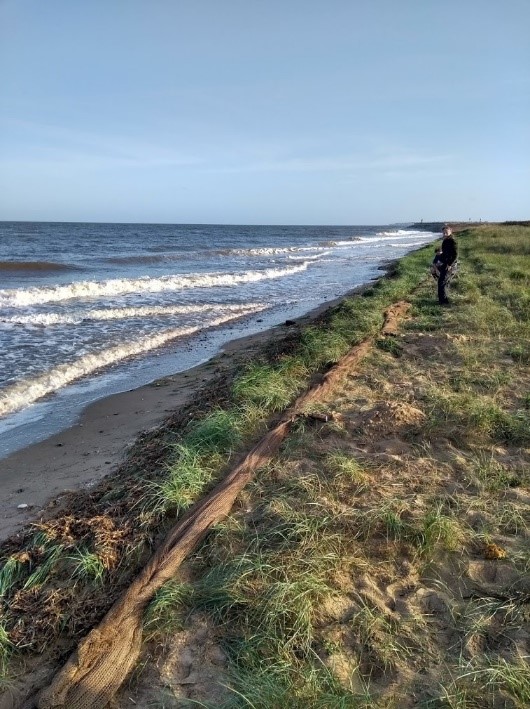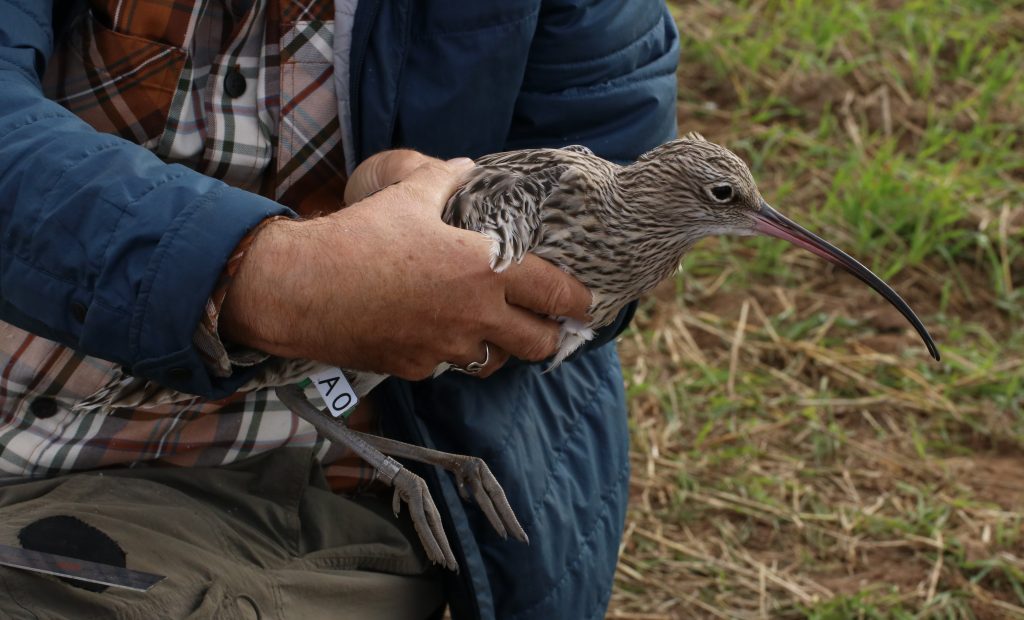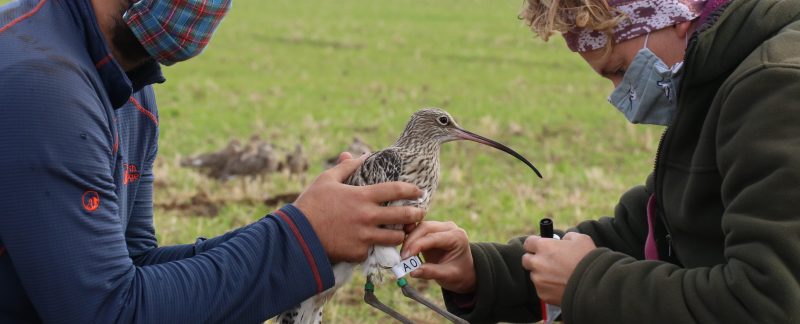Friday 18 September
Lizzie and Ryan arrived on Thursday evening and were kindly let into the house by Cathy, who joined them for dinner and a catch-up. Richard arrived shortly afterwards, and a plan was made for recces the next morning.
On Friday morning, Guy joined the team and recced the Royal Estate, Richard went over to Holbeach, Ryan recced Ken Hill and Lizzie covered Snettisham and Heacham beaches. The morning was crisp and clear with a light onshore breeze. At Holbeach, 19 Greenshank were on the usual pool, 13 Ringed Plover were found on a field at Gedney and 20 Curlew also on a field at Gedney, with more wanting to join, but they were pushed off by dog walkers. A few Curlew were also present on one of the military targets with a large number of gulls.
On Snettisham beach, Lizzie found a nice flock of 300 Sanderling which stayed in a relatively tight flock despite being pushed up and down towards the dam by walkers and dogs. The Oystercatchers were in the usual place, but then moved south towards the pits and were joined by the godwit. 100+ Curlew flew inland from the beach over Ryan with the majority of Curlew on the flats going south.
Ryan got to Ken Hill and found the newly ditched area to be very dry and covered in a blanket of thick low-lying mist. There had been some recent scrub clearance with an excavator still present and small brush fires burning in several places. A flock of 100 Curlew came over, circled the fields high then split with 20 birds heading towards the hill and the rest going south towards Snettisham. The Curlew that went inland were likely those re-found when leaving on the typical resighting fields at the turning from the main road towards Heacham North North.

Guy found a lovely Curlew flock on a recently ploughed field on the Royal Estate. He managed to read c. 70 Curlew flags, which was a fantastic result and made a good start to the resighting totals for the trip.
After returning to our base and liaising with the remainder of the team, the decision was made that, based on the tides for Saturday morning, that the Sanderling was the best option as we would lose this option as the tide height increased as the trip went on. After an excellent breakfast of bacon and pancakes kindly cooked by Lizzie, the team prepared four half-sized, small-mesh cannon net sets for Snettisham Beach. These were then set in the afternoon, with two pairs of two nets set inline at different heights allowing the team to hedge their bets on the tide and arrival of the birds on the beach. Strong winds and the expectation of a storm surge made the tide the next day difficult to predict.
Guy remained with the nets until dark. This was very fortunate because the evening tide was above the predicted height and so the lower line of nets needed to be lifted up the beach then brought back down again. A stellar effort by Guy to achieve this by himself.
Saturday 19 September

The team were up bright and early to man the set at Snettisham Beach in the hope of catching early in the lower set of nets before the tide came in too far and too many people were around on the beaches. Unfortunately, even at the time the team arrived, it was clear the tide was making and the time to make a catch was going to be very short. The lower set of nets became unsuitable for a dry catch shortly after we arrived. The team were joined by Nigel shortly after dawn who acted as a second observer to the south. An hour before the tide, small groups of Sanderling started moving up and down the beach and over the water. A flock of 150 birds briefly showed an interest below our higher net set, but they quickly moved north along the beach towards the dam, later leaving the beach and moving north as the tide came in. This was to be the story of the morning with the birds just not quite playing ball, eventually leading Richard to call it in preference of saving what kit we could from being inundated by the sea. Nigel left for the Royal Estate in the hope of picking up the Curlew observed by Guy the previous day.
The sets were watched over high tide and pulled back away from the tide edge where required, with the hope of making a falling tide catch. Unfortunately, this was not to be and, with no birds returning to the beach, both sets of net were collected, and the team went off for breakfast.
Fortunately, Nigel managed to locate two Curlew flocks on suitable fields on the Royal Estate. The first being on the field Guy found on the previous day, a recently deeply ploughed field where Nigel got another 80 Curlew resightings. However, the second field was disced and weedy, so this option was preferable. It would have been hard to hide and camouflage the nets in the furrowed field and we know that Curlew are not keen to walk across this substrate. Two full, wide cannon nets were set inline at our best guess of the bird’s location as, unfortunately they had left very little in the way of feathers or droppings to go by. Nigel and Guy went off to find a suitable location for calling the catch.
The evening winds made mist-netting impossible and so the team had an evening off.
Sunday 20 September
The day started bright and early with another cannon-net attempt. The team were hopeful that it would be more successful than the previous morning. As high tide approached and Curlew began coming over onto fields, it was clear this would be another uncertain morning. Several hundred Curlew came over in multiple flocks but, unfortunately every time they showed a preference for a field it was two fields to the north of where we were set and they were not keen to come to ‘our’ field. The team’s expectations were waning but, just as we thought our luck had run out, a small flock of 50 Curlew and a few Bar-tailed Godwit flew in and split in two, half coming and landing with our decoys and the other half returning to their original location. At 08:45 a single net was fired, and we ended up with 23 Curlew and three Bar-tailed Godwit.
After processing the team decided it was worth setting on the fields to the north to try for a second catch the following day and set a single full, wide net.

Catch totals
| Species | New | Retrap | Total |
| Bar-tailed Godwit | 3 | 0 | 3 |
| Curlew | 20 | 3 | 23 |
| Curlew | 20 | 3 | 23 |
| Bar tailed Godwit | 3 | – | 3 |
| Totals | 23 | 3 | 26 |
The wind had dropped sufficiently during the day for the team to attempt mist-netting in the evening. In a change to the usual process, due to team sizes, gate entry and timings, the decision was made to prepare dinner, take it with us then set the nets, eat, and wait for the tide. This worked very effectively with a small team. As in August, nets were set on the white-barn pool as this is the most convenient to run with a small team. A total of eight mist-nets were set in two lines, but in a slightly different arrangement on the main pool to usual. This proved to work well though whether it was better than the usual arrangement who can say. In total, 89 birds were caught over the evening (86 ringed plus three retraps). A fairly modest number given the usual catches at Terrington Marsh, but a perfect number for a small team working under Covid-19 restrictions.
A welcome change for processing was using battery-powered lighting purchased for the group by Richard. These small lithium battery-powered work lights provided excellent lighting and lasted easily for the whole processing session. The absence of continual noise from a petrol generator was welcomed by the team.
Catch totals
| Species | New | Retrap | Total |
| Grey Plover | 1 | 0 | 1 |
| Knot | 6 | 0 | 6 |
| Dunlin | 38 | 1 | 39 |
| Bar-tailed Godwit | 3 | 0 | 3 |
| Black-tailed Godwit | 3 | 0 | 3 |
| Curlew | 3 | 0 | 3 |
| Redshank | 29 | 2 | 31 |
| Turnstone | 3 | 0 | 3 |
| Totals | 86 | 3 | 89 |
Monday 21 September
With a feeling of déjà vu, the team were up early for another, hopefully successful, cannon-net attempt on the Royal Estate. The set was slightly to the north on a rough grazed field where we often catch, as it is regularly uncropped and often used by Curlew at this time of year. Once the team were ready and the decoys deployed, Nigel made an exit hoping to boost our resightings totals for the trip by going to look for other Curlew flocks in the area. As high tide approached, the situation looked promising with Curlew arriving in the field in small groups (2–5s). Unfortunately, although a couple of these landed with the decoys, the majority were landing further towards the centre of the field away from our set. The 2–3 birds we had gained rapidly walked out of our set to join the larger and increasing nucleus of birds there. The team prepared themselves for a blank morning, something which Lizzie and Richard were particularly disappointed about given the location of their firing position meant they had to endure the smell of a particularly pungent dead hare. However, luck was with us and just as things looked lost, a Marsh Harrier approached flushing the nucleus of birds, with 20 landing in our decoys with others slightly beyond the net. At this point Richard fired, catching 13 and a single Bar-tailed Godwit. The birds were rapidly processed and colour-marked, further increasing our colour-mark samples for 2020.
Catch totals
| Species | New | Retrap | Total |
| Bar-tailed Godwit | 1 | 0 | 1 |
| Curlew | 12 | 1 | 13 |
| Totals | 13 | 1 | 14 |
After a successful trip so far and promising weather conditions for the coming evening, the team decided to repeat the mist-netting structure from the previous evening. So again, down to the white-barn pool we went. Nigel’s years of experience lead him to conclude that the large tides during the early part of the trip meant the marsh would have flooded and birds would have roosted elsewhere and now, a couple of days later, they would be back to using the marsh. His theory proved correct, at least based on the totals, as 145 birds were caught this time, but with no retraps. The majority of birds being Dunlin, followed by Redshank. We also added colour-marks to seven Knot taking the trip total to 13.

Catch totals
| Species | New | Retrap | Total |
| Knot | 7 | 0 | 7 |
| Dunlin | 77 | 0 | 77 |
| Bar-tailed Godwit | 3 | 0 | 3 |
| Black-tailed Godwit | 3 | 0 | 3 |
| Curlew | 3 | 0 | 3 |
| Redshank | 50 | 0 | 50 |
| Turnstone | 5 | 0 | 5 |
| Totals | 145 | 0 | 145 |
Tuesday 22 September
The decision was made not to make a cannon-net attempt on the morning of the 22nd. as we had done well and there were a lot of tasks around the base house that needed to be done, especially with the prospect that a team might not be back for some time. Out came the paperwork, power washer, trowels and tools with tasks including to continue the patio re-grouting, data checking, cleaning etc.
The last evening took the team to Gedney. It had been a long time since the group attempted a mist-netting session at this site, in part as few people know the route out and set up. Anyway, out we went ending up setting eight nets in three lines across the main pool. An unexpected increase in wind speed, though still safe, meant the team were not hopeful for the catch to come. Half the team went out to man the nets, a couple of quiet rounds passed then, just as Nigel had settled down for a nap in the camper, across the radio came ‘Hey guys, can you come out it is getting quite busy….’. How wrong our guesses at the low double figures for the evening were with 120 birds caught. This total added another 19 Knot to our colour-mark sample.
Catch totals
| Species | New | Retrap | Total |
| Grey Plover | 3 | 0 | 3 |
| Knot | 19 | 0 | 19 |
| Dunlin | 45 | 0 | 45 |
| Bar-tailed Godwit | 4 | 1 | 5 |
| Black-tailed Godwit | 1 | 0 | 1 |
| Redshank | 45 | 0 | 45 |
| Turnstone | 2 | 0 | 2 |
| Totals | 119 | 1 | 120 |
The September trip, just like August was very successful under the circumstances. With excellent contributions towards our colour-mark studies, in particular for Knot with 107 individuals marked by both teams. The August trip had allowed the group to iron out the small kinks in our Covid-19 procedures so by September these were easy and straightforward to follow. Again, they were done without incident. Despite the success, just as in August, it was sad to not have our large social teams and those members not there were dearly missed.
Trip Ringing Totals
| Species | New | Retrap | Colour-marked | Overall Total |
| Grey Plover | 4 | 0 | 0 | 4 |
| Knot | 32 | 0 | 32 | 32 |
| Dunlin | 160 | 1 | – | 161 |
| Black-tailed Godwit | 10 | 0 | – | 10 |
| Bar-tailed Godwit | 11 | 1 | – | 12 |
| Curlew | 35 | 4 | 32 | 39 |
| Redshank | 124 | 2 | – | 126 |
| Turnstone | 10 | 0 | – | 10 |
| Total | 386 | 8 | 64 | 394 |
September Resighting Totals Overall
| Species | Total Sightings | Individuals | WWRG | Non-WWRG |
| Curlew | 172 | 88 | 172 | 0 |
| Knot | 1 | 1 | 1 | 0 |
| Bar-tailed Godwit | 11 | 11 | 11 | 0 |
| Redshank | 17 | 14 | 16 | 1 |
| Oystercatcher | 1 | 1 | 0 | 1 |
| Total | 202 | 115 | 200 | 2 |

